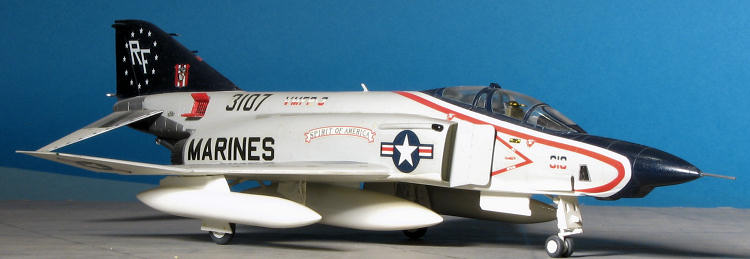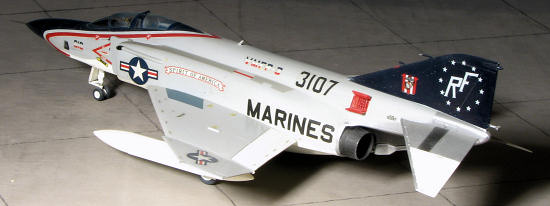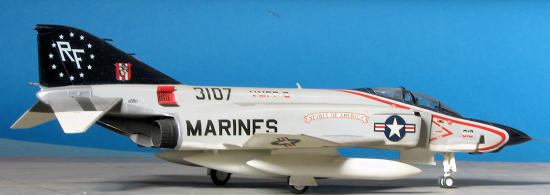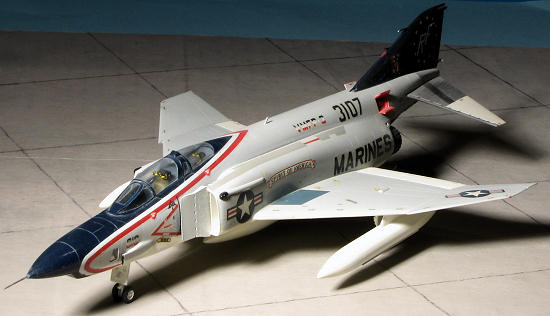
Fujimi 1/72 RF-4B Phantom II

Kit Number: G 13
Price: $15.00 (In 1987)
Decals: several versions, all VMFP-3
Reviewer: Scott Van Aken
Date of Review: 20 August 1997 - Date of build : November 1987
 The F-4 Phantom II is the epitome of US Airpower in the 1960s and early 70s.
With the exception of the Army, all branches of the US military flew
this huge, powerful and loud aircraft. The RF-4B is the only version
that was never armed, unlike the RF-4C that eventually had a number of airframes
modified for Sidewinders. 'Alone, unarmed, and unafraid' has long been
the motto of the recce pilot, and the RF-4 was able to do add 'fast' to that
motto as its Mach 2 capabilities helped ensure the survival of its pilots.
The F-4 Phantom II is the epitome of US Airpower in the 1960s and early 70s.
With the exception of the Army, all branches of the US military flew
this huge, powerful and loud aircraft. The RF-4B is the only version
that was never armed, unlike the RF-4C that eventually had a number of airframes
modified for Sidewinders. 'Alone, unarmed, and unafraid' has long been
the motto of the recce pilot, and the RF-4 was able to do add 'fast' to that
motto as its Mach 2 capabilities helped ensure the survival of its pilots.
Fujimi was probably the first model maker to utilize the component method of allowing a large number of kits to be built using many of the same parts from kit to kit. This allowed them to model virtually all the F-4 variants (except the F-4A). As Fujimi increased their kit production of the F-4, later versions showed improvements over the earlier ones. As an example, the early runs had a very poor fitting and sparsely detailed interior. As later versions were released, the interior was changed and improved a great deal to help reflect the differences between types.
The downside to the use of similar molds for multiple versions is that there are a large number of very small parts and subassemblies. In the more modern Hasegawa kits of the Phantom, there are different fin caps, parachute housings, and other bits and pieces that add to the complexity of the kit and therefore increase the opportunity to mess up the kit. Having said that, the best British Phantoms in 1/72 are the ones made by Fujimi, so if you see them on sale, do yourself a favor and pick up several.
 All the Fujimi Phantom kits are molded in grey plastic with fine engraved
panel lines. There is fine detail on the gear doors, but the gear wells have
only the basic structure with no detailing. The intakes are sufficiently
deep to provide the proper illusion. The intakes on all the US Phantoms
are also the area of greatest problem during assembly. I have never
gotten a good fit on these items and have always had to do more sanding and
puttying than I would have liked in this area. I have also had to use
filler on the wing to fuselage join, especially the underside forward section.
All the Fujimi Phantom kits are molded in grey plastic with fine engraved
panel lines. There is fine detail on the gear doors, but the gear wells have
only the basic structure with no detailing. The intakes are sufficiently
deep to provide the proper illusion. The intakes on all the US Phantoms
are also the area of greatest problem during assembly. I have never
gotten a good fit on these items and have always had to do more sanding and
puttying than I would have liked in this area. I have also had to use
filler on the wing to fuselage join, especially the underside forward section.
With the myriad of stores available for the F-4, you have a number of holes in the lower wings to open depending on what you are carrying. The nose section of the RF-4 is an area that needs very careful assembly. The nose itself is divided vertically, resulting in all the lower camera windows having to bridge the two halves. While I have always managed to have this area look good, it has always taken putty and sandpaper to get a perfect fit. If I were to be designing this section, I would design it so that the transparencies could be added after the nose is assembled. I would also provide some cameras, as these items are missing from the kit. A nice touch on Fujimi kits is the ability to have the flare doors open or shut, although on the non-RF kits, this area needs to be kept closed. Fujimi provides the correct non-bulged wing and skinny wheels for all but the last 12 RF-4Bs as well as add on ECM bulges along the intakes. As with all the F-4 kits I have built, there is no need for nose weight.
 Painting the Phantom can be as easy or difficult as you wish depending on
the scheme you chose. If you do not like using metal paints, then the
F-4 is not for you. The aft section requires several shades of metallic
paint to get a good effect. This is because of the use of different types
of metal as well as the effects of heat on these metals. As you look at the
photos of F-4s, you will see the many different tones used. This particular
kit was painted in standard light gull grey over white and used the kit decals.
Although the photo does not show it, the Fujimi decals suffered from
a slight transparency and an odd red that is endemic with Japanese decals.
I chose the decals as they are really nice markings. The tail and nose were
painted with Gunze acrylics and here I ran into a problem that can happen
with acrylic paints. I did not let the under coats dry completely before
adding top coats. As a result, at least on the tail, the undercoats
dried after the top coat did and the surface cracked as the undercoat shrank.
This phenomena is usually not visible until several weeks after the
kit has been completed, with the result that the decals have already been
applied. In my experience, it is more prevalent with darker colors,
but can happen with all shades.
Painting the Phantom can be as easy or difficult as you wish depending on
the scheme you chose. If you do not like using metal paints, then the
F-4 is not for you. The aft section requires several shades of metallic
paint to get a good effect. This is because of the use of different types
of metal as well as the effects of heat on these metals. As you look at the
photos of F-4s, you will see the many different tones used. This particular
kit was painted in standard light gull grey over white and used the kit decals.
Although the photo does not show it, the Fujimi decals suffered from
a slight transparency and an odd red that is endemic with Japanese decals.
I chose the decals as they are really nice markings. The tail and nose were
painted with Gunze acrylics and here I ran into a problem that can happen
with acrylic paints. I did not let the under coats dry completely before
adding top coats. As a result, at least on the tail, the undercoats
dried after the top coat did and the surface cracked as the undercoat shrank.
This phenomena is usually not visible until several weeks after the
kit has been completed, with the result that the decals have already been
applied. In my experience, it is more prevalent with darker colors,
but can happen with all shades.
Overall, I was quite pleased with the kit. The components fit rather well and are accurate. I figure I have built probably 15-20 Fujimi Phantoms over the years and will build more in the future. Not recommended for the beginner as much for the decals as anything else.
Copyright ModelingMadness.com. All rights reserved. No reproduction without express consent.